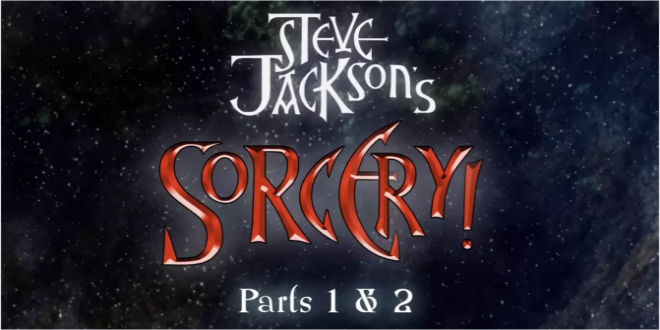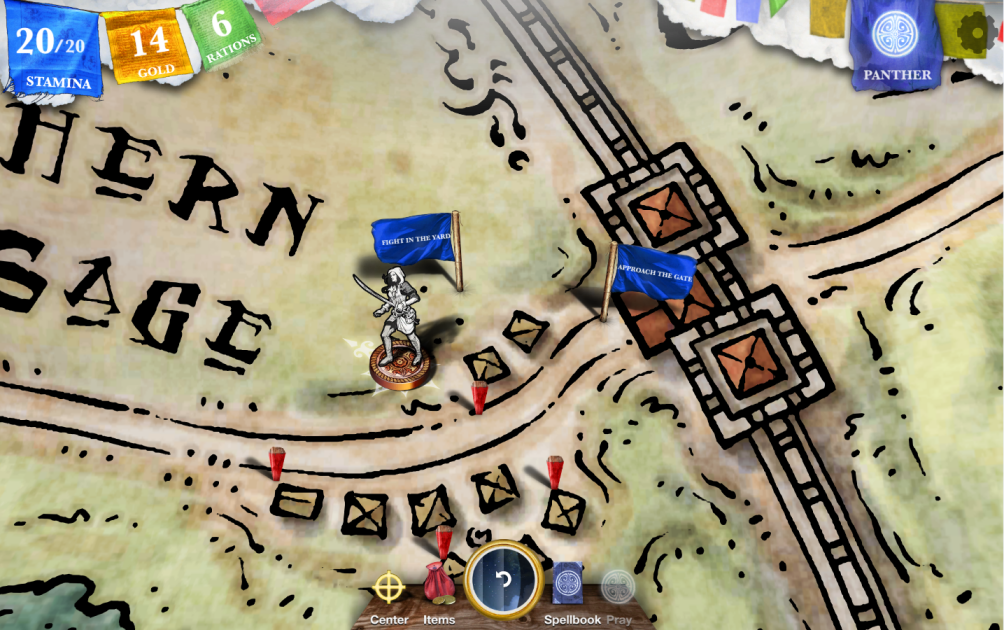[UPDATE] Your friendly neighborhood wordslinger has to apologize for leaping to assumptions: there are TWO old-school Steve Jacksons, one in the US and one in the UK. The Fighting Fantasy gamebook series is NOT by the same guy who did GURPS, and if I'd checked Wikipedia instead of running with my gut (and increasingly failing memory), I'd have known that. Thanks to our readers for picking up on the mistake so I could get you accurate news ASAP!
Steve Jackson's venerable Fighting Fantasy gamebooks started moving into the mobile-gaming medium years ago, and now Inkle Studios has ported over its successful launch of the Sorcery! segment for that series to the PC platform.
Now, it's true that Sorcery! was made for mobile platforms, which means "shovelware" to a lot of PC gamers. Most mobile games are geared for platforms which are telecommunications devices first and provide gaming as an afterthought, with fewer resources than even a low-end dedicated handheld. Does Sorcery! make the proverbial silk purse of all this?
Well, it was a Game of the Year Finalist for each of TouchArcade, Mashable and Gamezebo, which should suggest a worthy candidate for porting to PC. If it helps any, games which ranked near Sorcery! in those lineups included the mobile versions of Deus Ex: The Fall, Don't Starve and The Wolf Among Us, and Metacritic ranks the series in the mid-to-high eighties. Let's find out for ourselves.
POLYGONS ARE FOR DICE
One thing to bear in mind is that Sorcery! goes for the storytelling angle, and not just by handing you a linear tale to read. Instead of trying to cram a AAA 3D-modeled extravaganza into a phone, Inkle made the smart play, remembering that role-playing games used to rely on text supported by relatively primitive visual aids. The idea here is to frame the situation for the player's imagination. This is something Inkle manages to accomplish without need of high-tech gimmickry.
Perhaps not so surprising, considering the series wasn't even originally intended for iOS - when it was written and published between 1983 and 1985, as part of the fifty-nine-book Fighting Fantasy RPG series, cell phones didn't exist. Sorcery! isn't just a callback to the halcyon days of sketched-out maps, pencils, character sheets and a handful of dice, but a faithful translation of a bit of that era to digital media. The interface remains geared for a mobile touchscreen, but that's no kind of hindrance for what boils down to an augmented, super-sized, pick-your-path adventure campaign.
HIT THE ROAD, JACK
Dragging a line from your character's figure to a nearby destination (marked by a blue flag) moves you there, opening up a series of choices in text, which is the same as the original game. As you move across the map, new places, options and decisions will open up for you to explore, most of which branch from the choices you've already made.
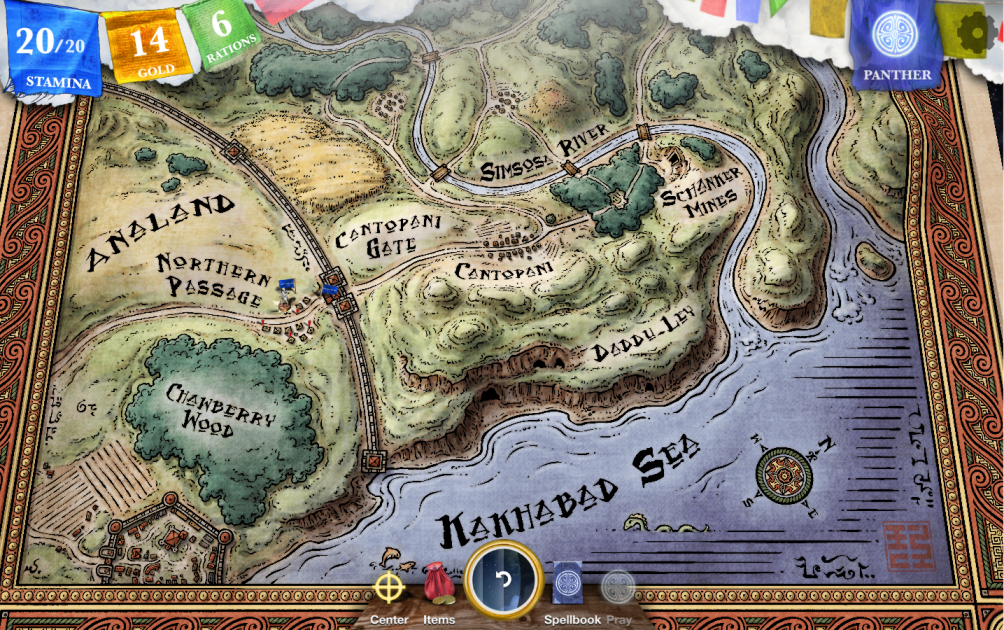
Using the mouse wheel will let you zoom the map out. As you can see, there's quite a few places to explore, and this is just the southern half of the Shamutanti Hills. Problem is, rarely do you have more than a few directions to go at any one time, and even more rare are chances to retrace your steps. If you were forced to save-scum your way through the game in order to see everything there is to see, that'd get very annoying very quickly.
Fortunately, an even better option than saving and reloading is actually built into Sorcery! - a mechanic which really lends to experimentation and exploration. By clicking the "rewind" symbol, you can scroll backwards to any decision point in the game and try something different. Neat!

Along the way, you'll be presented not just with decisions and dialogue, but the original art as it appeared for publication more than thirty years ago. It's a very real glimpse into the foggy origins of role-playing history.
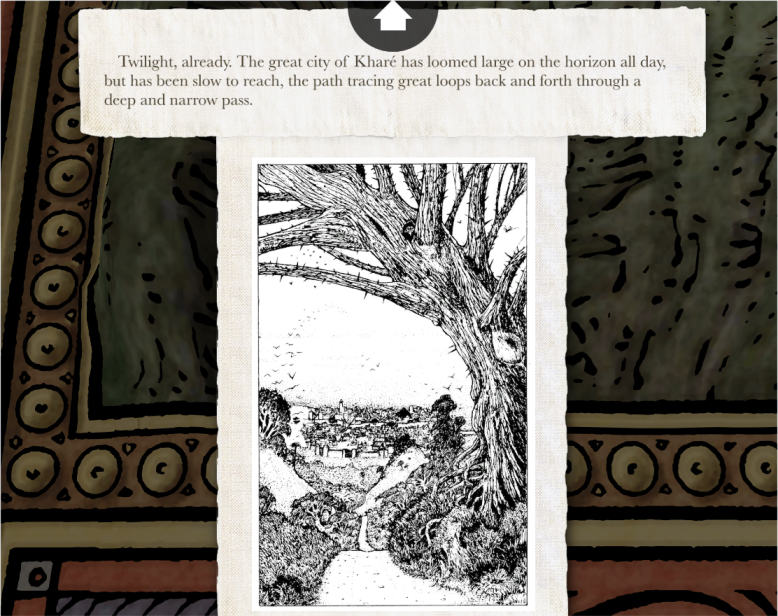
Ultimately your quest is to find the lost Crown of Kings, somewhere beyond the Shamutanti Hills (Episode 1) and Kharé, the Cityport of Traps (Episode 2). At the end of each episode, Sorcery! remembers your deeds and playstyle, which will alter how the next episode and its story both unfold. In this way, Sorcery! is somewhat like a graphics-light Telltale game, focusing on giving you more decision-making options and an actual (if somewhat simplistic) combat system.
INVENTORY - GET YOUR GEAR AND GO
Inkle used the KISS principle here, just like the original game. You've got your sword for fighting, your gold for buying, and your rations for replenishing some Stamina at the end of a long day's adventuring. Here and there you may pick up or buy rare and unusual items, but there's no weight or encumbrance-juggling to concern yourself with. Anything else that's special (keys, clues to mysteries, miscellanea) will all show up here in their own categories.
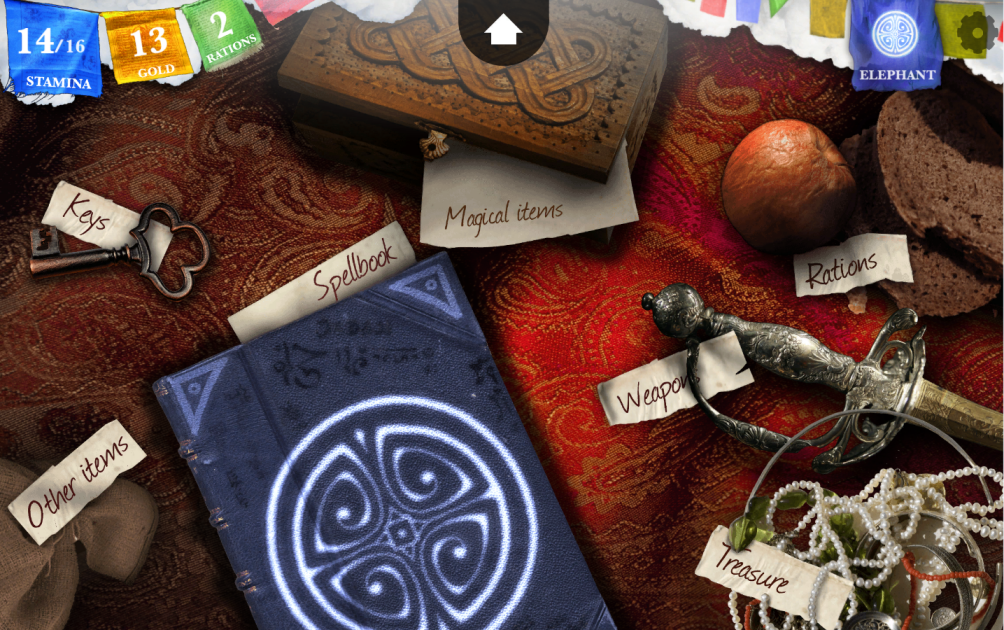
KILLIN' WHAT NEEDS KILLIN'
If you go into combat, you'll fight each round by deciding exactly how much force you want to put into your attack. The stronger the attack, the more it will tire you out, reducing your Attack Power for the following rounds. Going purely on defense or using light attacks will help you recover. If you and your opponent each commit to the attack, the more powerful will win. Victory is achieved by reducing your foe's Stamina to zero.
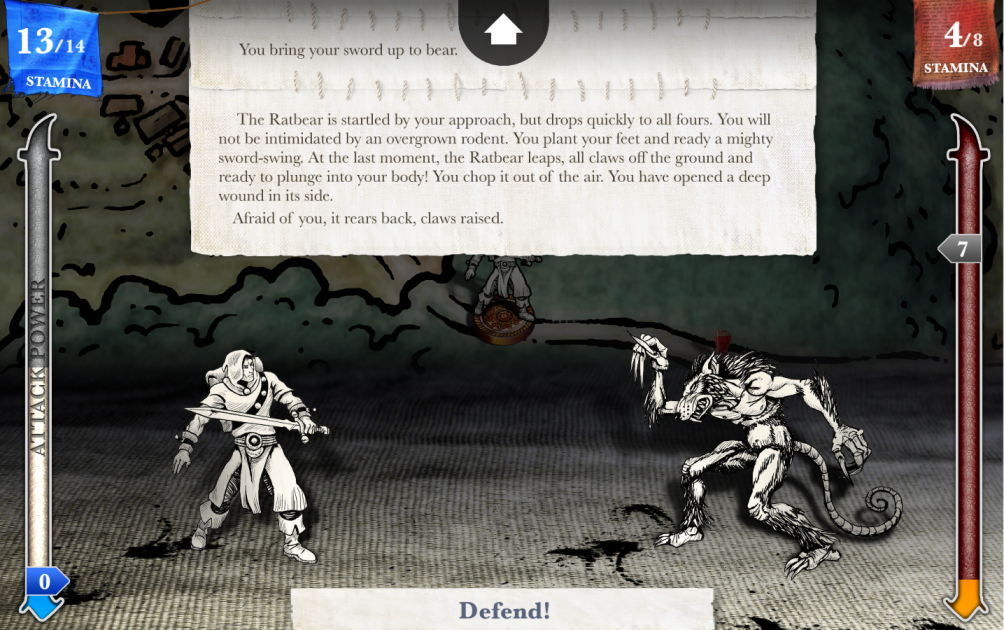
Reading the text to see what your enemy is doing before you commit yourself is a good way to maximize combat effectiveness. In addition, some non-human enemies may have special attacks or be susceptible to particular magic spells.
It's important to remember that there's no "experience system" and no "leveling up" here. Not all enemies will have treasure either, but all of them are capable of draining your Stamina. Fights exist mainly as obstacles to be overcome, so pick them carefully. You'll be just as often able to rely on diplomacy or spellcraft when navigating various predicaments.
IT'S CALLED SORCERY! FOR A REASON
In most games, it's a matter of Swords OR Sorcery. Here, it's both. Your ability to fight doesn't interfere with your ability to sling magic around, nor vice-versa. There are forty-eight spells you can cast as situations allow for, as long as you have your spellbook.
...and the Stamina to cast a given spell.
...and any physical components it might require.
...and you're not tied up or under anti-magical effects.
...and you can remember the three-letter code for the spell you actually want to cast.
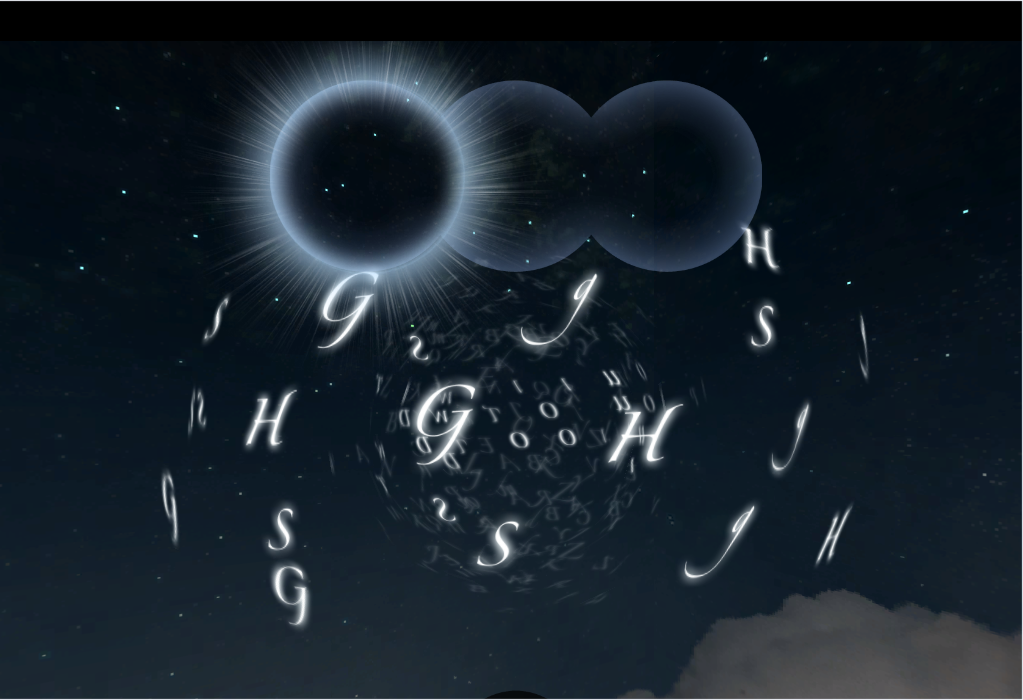
In combat or while otherwise under pressure, failing to have properly studied your spellbook can have real consequences! Most spellcasting opportunities slyly allow you to choose something that seems like it might work, but won't if you stop and think about why. Will casting a forcefield save you from that big Indiana-Jones-murdering boulder coming your way, or would it be cooler if six of yourself held it back by bodily force? Yeah, that ought to work!
Wait, aren't the other five of you insubstantial phantasms? Squish.
SOUNDS MAKE THE SETTING
For the opening and closing theme we get a suitably epic, full-orchestral treatment, which sounds like it would do well for the opening credits of Ralph Bakshi's Lord of the Rings.
Ambient sound is excellent, tailored to the locations you visit. Villages have dogs yapping, chickens clucking, peasants gabbling with one another. Winds blow through abandoned ruins as magpies caw. Drumbeats accompany the sounds of battle. Caverns drip, unseen beasts growl... is that the sound of your own heartbeat? Not much seems to be repetitive, either, adding to the sense of discovery as you explore these oft-cursed lands.
In a number of cases, this goes much farther than the mere requirements of filling dead air. You might find yourself voluntarily stopping to listen to a happy crowd and their local bard before resuming play. Nor are you prevented from moving on, if you wish. It's immersive, without getting in your way.
When you get right down to it, it's hard to imagine how Inkle Studios could have done much better breathing life back into a franchise older than most folks who play video games. The design is tight, clean, engaging and most importantly of all, fun in the old style. It's enough to make an old grognard pick up the mobile version just to play Episode 3, which is already out via Google Play and the App Store.
This game was reviewed on a PC using Windows 7 using a review code provided by Inkle to TechRaptor.
Are you considering trying out this PC port? What do you think of the challenges facing mobile game developers? Sound off in the comments below!
Review Summary
An immersive fantasy roleplaying experience with classic style and excellent presentation.
(Review Policy)Have a tip, or want to point out something we missed? Leave a Comment or e-mail us at tips@techraptor.net
